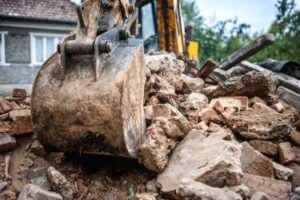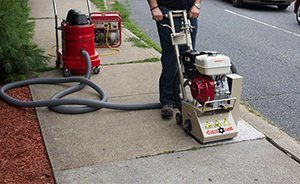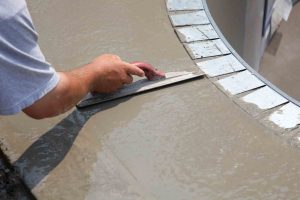What is Silica Dust?
Silica dust is made of very fine particles of quartz, which is a very common mineral. It’s one of the most common elements on the planet and found in a wide variety of manufactured and natural materials such as sand, brick, masonry, clay products, mortar, rock, concrete, gravel, granite, slate, sandstone, glass, and more. Silica dust, also called crystalline silica, is very fine and cannot be seen in the air, but large levels of visible dust are a good indicator that airborne silica particles are present.
How is Silica Dust Harmful?
Exposure to fine particles of silica dust causes silicosis. Silicosis is a severe lung disease that can be fatal. It is caused when fine particles get deep into the lungs, where coughing and breathing cannot remove them. Since quartz particles are sharp and angular, they create small cuts that damage and scar the lung tissue.
Silicosis can develop within a few weeks of exposure or show up decades after exposure. The condition causes severe scarring and stiffening of lung tissue, causing breathing difficulty, fatigue, and chest pain. It can also increase the risk of lung diseases including, tuberculosis, chronic bronchitis, and lung cancer. Over time, those with silicosis may need oxygen or other devices to help them breathe.
How much Silica Dust is Too Much
Since the dust cannot be coughed or breathed out, it only takes a small amount to create a significant hazard. Because it is very harmful, the Occupational Safety Health Administration (OSHA) requires employers to protect workers. In recent years, OSHA has increased the standards for construction, maritime, and general industry employees. The new rule includes an exposure limit, requires the use of engineering controls (such as water of vacuums) to limit exposure, provides medical monitoring for workers who are at high risk of exposure, and helps employers protect workers from exposure.
What Causes Silica Dust Exposure?
When employees grind or cut concrete, stone, or masonry, fine particles of dust are thrown into the air. This dust contains silica and other materials that can be easily inhaled. Harmful particles can be in the air even if there isn’t any visible dust. Since they get deep into the lungs, the most dangerous particles are the smallest, and they are too tiny to be seen with the naked eye.
Concrete Cutting and Breaking Activities That Can Create Silica Dust
Cutting and breaking concrete is hard work and often requires the use of heavy-duty power saws, jack hammers, grinders, and drills. Since concrete contains quartz, these tools throw silica dust into the air. Hazardous activities include:
- Cutting bricks, concrete blocks, and similar materials with a stationary masonry saw
- Cutting masonry, block, tile, or rock with a handheld masonry saw
- Grinding surfaces for finishing and cutting slots with hand-operated grinders
- Mortar removal or tuckpointing deteriorating mortar with handheld angle grinders
- Demolishing concrete, asphalt, and other materials with breaker hammers or jackhammers
- Cutting or drilling holes in concrete or other masonry construction materials with rotary hammers, saws, and drills
- Drilling through rock, soil, or concrete with vehicle-mounted drilling rigs
- Sanding drywall or joint compound during drywall finishing
- Cleaning construction and renovation sites with dry brooms, blowers, and compressed air
- Breaking, crushing, dropping, tossing, pouring, and driving over dusty debris
Common Silica Dust Control Measures
In general, any activity that reduces visible or invisible dust lowers the amount of silica in the air making the work area safer. There are a variety of techniques used to keep dust from becoming airborne and from lingering in the air including wet cutting, vacuum dust collection systems, ventilation booths, fans, and the use of respiratory protection. The use of one or more of these techniques can prevent unnecessary silica dust exposure and create a safer work site.
Wet Cutting
Wet cutting significantly reduces the amount of dust in the air and is an effective method for controlling dust during sawing. Many stationary saws are equipped with a water basin or can be attached to an accessory that sprays water on the surface while the saw is running.
Vacuum Dust Collection Systems
Vacuum dust collection is an excellent alternative to wet cutting. It is also commonly used with grinders and sanders, which need a dry surface to work properly. There are a wide variety of systems that can be attached either directly to the tool, or to the back it. When the tool is in use, the vacuum collects any dust created and captures it in a bag or other container.
Ventilation Booths
Ventilation booths are sometimes used when other equipment isn’t available or in areas where a small amount of work is being performed. A small enclosure is erected around the work area, and a large exhaust fan is placed at the rear wall to pull dust away from the work area.
Fans
Fans are effective at removing dust and should be used in addition to other dust control methods. A large exhaust fan placed in a window or doorway will remove any lingering dust that accumulates in the air.
Respiratory Protection
Respiratory protection is used during activities that generate a large amount of dust or in areas where dust tends to accumulate or linger. Since some activities create more hazards than others, it is common that some employees may wear a face mask while others do not.
General Housekeeping Practices
There are a wide variety of techniques that can reduce the amount of silica dust in construction or renovation areas including the use of dust suppressants, spraying with water or mist, fogging or steaming, electrostatic emitters, vacuum filters, surfactants and wetting agents, and more. Airborne particles can also be significantly reduced by the following standard practices:
- Cleaning up debris before dust spreads
- Wearing protective aprons or coveralls to keep dust off clothing
- Working upwind of dust sources
- Keeping roadways and walkways damp
- Wetting silica-containing debris and spoil piles before disturbance
- Limiting dry sweeping and the use of compressed air to clean surfaces



